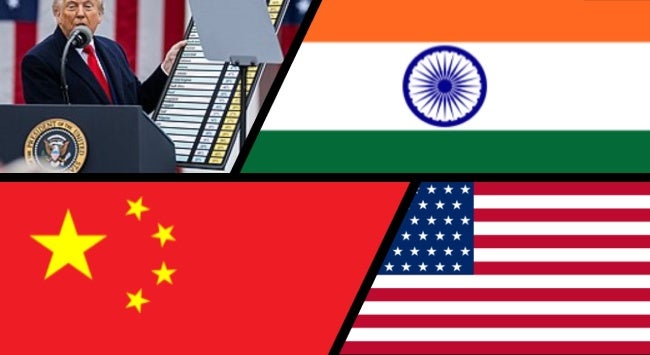Summary
Recent escalations in United States-China trade tensions increase worries for India. With both committing and non-committing to having high prices, India faces tough policy choices.
The trade friction between the United States (US) and China has escalated in the run-up to the Asia-Pacific Economic Cooperation (APEC) meeting scheduled in Seoul at the end of October 2025. This increases worries for India, which is struggling to manage impacts of high US tariffs. Even if the current tensions are dissolved, India, like many other middle powers and large economies of the world, will have to be prepared to cope with the multiple downsides of the rivalry.
The latest friction comprises China expanding curbs on export of rare earths and introducing controls on foreign production of rare earths consisting of Chinese materials. New controls have been announced for use of Chinese rare earths and processing technology in foreign defence and military use and semiconductors and their re-export. A global licensing system will kick in on 1 December 2025 to screen the use of rare earth magnets and critical materials sourced locally from China and further used in any supply chains.
The US’ reaction to the Chinese curbs has been predictably aggressive. President Donald Trump announced 100 per cent additional tariffs on Chinese exports. The retaliation comes on the back of both countries increasing the docking fees for ships made or run by the other, in their ports, in an ostensible effort to reduce each other’s control over global shipping services.
While reciprocal tariffs on countries with whom the US had cut deals begun getting implemented from August 2025, those for China were held back for 90 days. The truce was timed by factoring in a meeting between Trump and Chinese President Xi Jinping at the APEC summit. It is not clear yet whether the leaders will meet at APEC after the current muscle-flexing.
Neither China nor the US are backing down from a raw display of their respective economic might and the desire to control the global market, trade and strategic supply chains. The US’ weaponization of tariffs and export of chips has now been ‘complemented’ by China’s weaponisation of its near-monopoly control over global rare earth supply chains. The fight is unlikely to end if both presidents meet at Seoul. Both will keep working towards chipping away each other’s strategic ambitions. Newer geoeconomic tactics will be employed leading to greater fragmentation of critical supply chains and reorientation of global trade.
The weaponising tactics and their impact on supply chains and global trade have major implications for the world, including India.
Both the US and China will try persuading, or coercing, their trade partners, especially large ones like India, to make concessions favouring them more beneficial at the expense of the other. India stands at a crossroads in this regard.
India has not yet been able to cut a trade deal with the US. Its relations with the US have stumbled due to the US imposing high tariffs and its sudden bonhomie with Pakistan. On the other hand, despite a recent thaw in India’s ties with China resulting in resumption of direct flights and tourist visas, the trust deficit continues to prevail.
Both the US and China will be watching India closely to ensure that their respective strategic interests are not compromised by India’s economic policies. While the US insists on India stopping the purchase of Russian oil, China insists on guarantees that rare earths exported to India will not further processed and re-exported to the US or its allies. China’s recent complaint to the World Trade Organisation (WTO) on India’s domestic subsidies in its Production Linked Incentive (PLI) scheme contradicting WTO’s national treatment clause – which discourages favourable treatment of local players over foreign producers – complicates policy choices for India.
India is struggling to retain policy autonomy and flexibility while navigating the US-China rivalry. The fight, till now, is proving costly. The US singled out India for making it an example for the rest of the world by ‘punishing’ it with higher tariffs for buying Russian oil. These tariffs can go only if India commits to stop buying oil from Russia. Such commitment will have strategic costs for India, both political by complicating ties with Russia and economic by switching to buying higher priced US energy in place of cheaper Russian crude. Staying uncommitted, as India has till now, will mean persisting with hits for major export-oriented industries – garments, leather, footwear and chemicals – that are job-intensive and facing displacement of labour.
On the other hand, China’s move against India’s subsidies is ostensibly to make India agree to a more level-playing field for Chinese ‘green’ investments (for example, electric vehicles, solar panels and batteries) for which it is keenly eyeing the Indian market. It might also be a ploy to withdraw subsidies from India’s major PLI beneficiary industry – smartphones – to make sure that Apple’s prominence as a smartphone producer in India does not go unchallenged and Chinese phone makers (for example, Oppo, Vivo and Huawei) can also tap the Indian market.
Its testing times for Indian diplomatic and trade policy efforts as it navigates choppy waters. All decisions will involve costs as there are prices for committing and not committing. Realism and assessment of larger economic benefits should decide the choices.
. . . . .
Dr Amitendu Palit is a Senior Research Fellow and Research Lead (Trade and Economics) at the Institute of South Asian Studies (ISAS), an autonomous research institute at the National University of Singapore (NUS). He can be contacted at isasap@nus.edu.sg. The author bears full responsibility for the facts cited and opinions expressed in this paper.
Pic Credit: Wikimedia Commons and ISAS
-
 More From :
More From :
-
 Tags :
Tags :
-
 Download PDF
Download PDF



